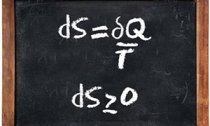 Thermodynamics is the study of heat and energy. At its heart are laws that describe how energy moves around within a system, whether an atom, a hurricane or a black hole. The first law describes how energy cannot be created or destroyed, merely transformed from one kind to another. The second law, however, is probably better known and even more profound because it describes the limits of what the universe can do. This law is about inefficiency, degeneration and decay. It tells us all we do is inherently wasteful and that there are irreversible processes in the universe. It gives us an arrow for time and tells us that our universe has a inescapably bleak, desolate fate.
Thermodynamics is the study of heat and energy. At its heart are laws that describe how energy moves around within a system, whether an atom, a hurricane or a black hole. The first law describes how energy cannot be created or destroyed, merely transformed from one kind to another. The second law, however, is probably better known and even more profound because it describes the limits of what the universe can do. This law is about inefficiency, degeneration and decay. It tells us all we do is inherently wasteful and that there are irreversible processes in the universe. It gives us an arrow for time and tells us that our universe has a inescapably bleak, desolate fate.
Despite these somewhat deflating ideas, the ideas of thermodynamics were formulated in a time of great technological optimism – the Industrial Revolution. In the mid-19th century, physicists and engineers were building steam engines to mechanise work and transport and were trying to work out how to make them more powerful and efficient.
Many scientists and engineers – including Rudolf Clausius, James Joule and Lord Kelvin – contributed to the development of thermodynamics, but the father of the discipline was the French physicist Sadi Carnot. In 1824 he published Reflections on the Motive Power of Fire, which laid down the basic principles, gleaned from observations of how energy moved around engines and how wasted heat and useful work were related.







